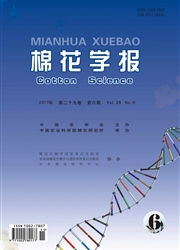

 中文摘要:
中文摘要:
利用已建立的叶柄组织培养体系,对大田棉株不同发育时期、不同部位的叶柄进行组织培养研究。叶柄和无菌苗下胚轴愈伤组织诱导培养基为MSB+IAA0.1mg·L^-1+KT0.1mg·L^-1+2,4-D0.1mg·L^-1+Glucose30g·L^-1+Gel2g·L^-1(pH5.8);叶柄愈伤组织分化培养基为MSB+IAA0.05mg·L^-1+KTO.05mg·L^-1+Glucose30g·L^-1+Gel2g·L^-1(pH6.5);无菌苗愈伤组织分化培养基为MSB+IAA0.02mg·L^-1+KT0.04mg·L^-1+Glucose 30g·L^-1+Gel2g·L^-1(pH6.5)。研究发现棉花主茎叶叶柄、果枝叶叶柄、营养枝叶叶柄在愈伤组织生长速度方面有一定差异.在愈伤组织诱导和分化方面,除严重衰老叶片的叶柄外,其它部位差异不显著。不同来源的胚性愈伤组织在MSB+6.BA0.05mg·L^-1+KTO.02mg·L^-1+Sucrose30g·L^-1+Gel2g·L^-1(pH6.5)培养基上,均能得到胚状体.并获得再生植株。可见棉花叶柄是优良的组织培养外植体。
 英文摘要:
英文摘要:
This research focused on the tissue culturing of cotton petioles in different parts and different developing stages using the established system of tissue culture of cotton petioles. The callus induction medium was MSB +IAA 0.1 mg·L^-1+KT 0.1 mg·L^-1+2,4-D 0.1 mg·L^-1+Glucose 30 g·L^-1+Gel 2 g·L^-1 (pH 5.8), for both the petioles and aseptic seedling hypocotyls as explants. The embryogenesis callus differential medium was MSB +IAA 0.05 mg ·L^-1+KT 0.05 mg ·L^-1+Glucse 30 g·L^-1+Gel 2 g ·L^-1(pH 6.5), for the calli of petioles. The embryogenesis callus differential medium was MSB +IAA 0.02 mg·L^-1+KT 0.04 mg·L^-1+Glucose 30 g·L^-1+Gel 2 g·L^-1(pH 6.5), for the calli of the aseptic seedling hypocotyls. For the petioles from the stem, the fruit branch and the vegetative branch as explants, the results revealed no significant difference in the ratio of callus induction and callus differentiation. For the senescence petioles as explants, there was significant decrease in the ratio of callus induction and callus differentiation. Embryogenesis callus could develop into embryoid and then into plantlets in the medium containing MSB+6-BA 0.05 mg·L^-1+KT 0.02 mg. L%Sucrose 30 g·L^-1+Gel 2 g·L^-1(pH 6.5 ). The results indicated that like aseptic seedling hypocotyls, cotton petioles were good explants for tissue culture.
 同期刊论文项目
同期刊论文项目
 同项目期刊论文
同项目期刊论文
 期刊信息
期刊信息
